I rather enjoyed reading this letter in the Telegraph today written by Lucy Anderson-
“Sir – It was a pleasure to hear the author Richard Hamblyn talking about clouds on the radio at the weekend. I enjoyed imagining the different types of sky he described. Mr Hamblyn said that Shropshire was a good place for cloud-spotting, because the hills produced fine examples. Somehow I had generally connected cloudscapes with the big skies one sees above flat countryside. Perhaps my assumption was partly based on the cloud-piled paintings of Constable depicting his native Suffolk. But on looking again at Constable’s cloud paintings on the internet, I find some of his most striking specimens were painted at his London home in Hampstead – a hilly spot. Do other readers find that clouds are more spectacular in some favourite spot?”
And here’s one of Constable’s cloud paintings from Hampstead-
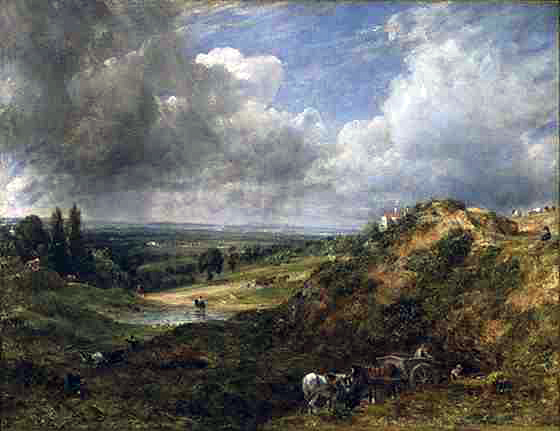
John Constable (1776-1837)
‘Hampstead Heath; Branch Hill Pond’Â 1828
Oil on canvas from the V&A Collection
It was an exhibition of photographs by Ansel Adams on display in Yosemite National Park which I saw while on a family holiday when I was 14 that first inspired me to take photographs. I was mesmorised by these sublimely beautiful images of the untouched American wilderness, and I remember being particularly struck by his ability to capture clouds. A feature of the landscape which had, until then, completely passed me by.Â
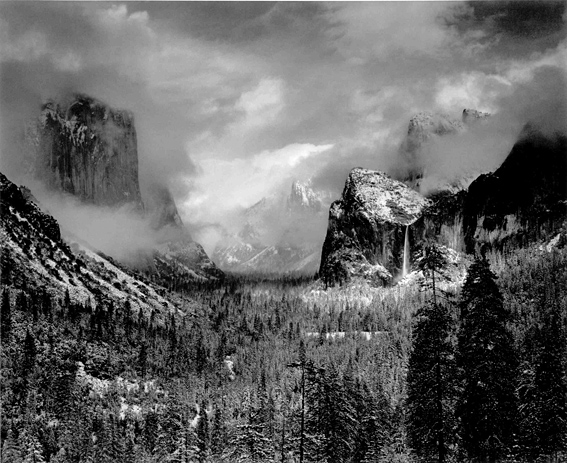
Ansel Adams, Yosemite Valley, 1942
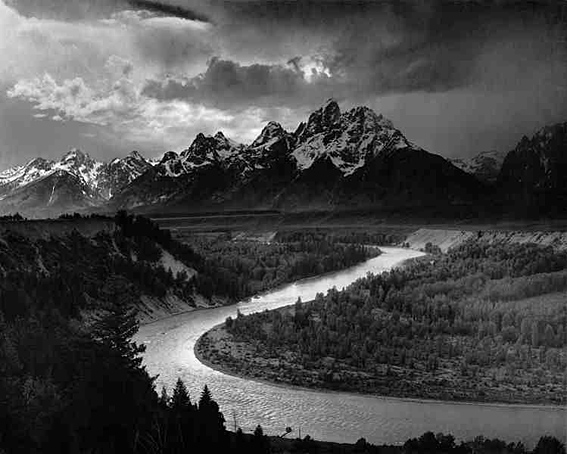
Ansel Adams, The Tetons and the Snake River, 1942
Â
Maybe I’m just a romantic, but I’ve been a fan ever since. Of Adams and clouds.Â
For other cloud fans out there, take a look at the Cloud Appreciation Society website.
Â
Posted in INSPIRATION | 1 Comment »
Here are a few quotes I’ve come across in my research over past few weeks, which I’ve found particularly interesting or inspirational. If you have any other suggestions, please post them below.
“Happy are those who see beauty in modest spots where others see nothing. Everything is beautiful, the whole secret lies in knowing how to interpret.â€Â
Pissarro (1893). Quoted in Britain Observed by Geoffrey Grigson (1975)
“My limited and abstracted art is to be found under every hedge, and in every lane, and therefore nobody thinks it worth picking up.â€Â
Constable (1832) on declaring he had never seen an ugly thing in his life. Quoted in Britain Observed by Geoffrey Grigson (1975)
“It is part of the photographer’s job to see more intensely than most people do. He must have and keep in him something of the receptiveness of the child who looks at the world for the first time or of the traveller who enters a strange country.â€Â
Bill Brandt (1948)
“One of the pleasures of being English is to return to this country after a longish time abroad, especially if you come up the Solent in a liner….soon familiarity blinds you again, but for an hour ot two you have caught a surprising vision of your country and your countrymen: you have notice a hundred details which are peculiar to England; you have, in fact been able to look through foreign eyes.â€Â
Raymond Mortimer from the introduction to Bill Brandt’s The English at Home (1936)
 “England has a much softer atmosphere. Colours just don’t sing the way they do in the States…When I got back to England I found everything so grey that I didn’t see any point in shooting in colour. It didn’t seem to be an important part of our lives….To me Britian is very much a black and white country…â€Â
Tony Ray-Jones from an interview in SLR Camera (1969)
 “We must live in a country and work there in order to understand its ways and customs – to travel through as a tourist is to see only clichés.â€Â
Tony Ray-Jones, Notes on Jean Renoir (c.1967)
 “One can learn a good deal about the spirit of England from the comic coloured postcards that you see in the windows of cheap stationers’ shops. These things are a sort of diary upon which the English people have unconsciously recorded themselves. Their old-fashioned outlook, their graded snobberies, their mixture of bawdiness and hypocrisy, their extreme gentleness, their deeply moral attitude to life, are all mirrored there.â€Â
George Orwell, The Lion and the Unicorn (1941)
“Englishness is continuous, it stretches into the future and the past, there is something in it that persists; as in a living creature. What can the England of 1940 have in common with the England of 1840? But then, what have you in common with the child of five whose photograph your mother keeps on the mantelpiece? Nothing, except that you happen to be the same person.â€Â
George Orwell, The Lion and the Unicorn (1941)
 “England is not at all a single category but a set of relationships. The nation exists in tension. Its fellow members remain deeply divided among themselves, but at the same time they constantly prove themselves ready to unite around certain issues, talismans and images.â€Â
John Taylor, A Dream of England (1994)
“The English have not devoted a lot of energy discussing who they are. It is a mark of self-confidence: the English have not spent a great deal of time defining themselves because they haven’t needed to.â€Â Â
Jeremy Paxman, The English (1999)
“In a society of individuals, loyalties are to kindred spirits. Instead of easy-going, random meetings of street life, the English do their socialising by choice and form clubs – ‘Who runs the country?’ asked John Betjeman rhetorically. ‘The RSPB. Their members are behind every hedge.’ And he was speaking long before the RSPB membership reached its present vertiginous levels of well over one million. There are clubs to going fishing, support football teams, play cards, arrange flowers, race pigeons, make jam, ride bicycles, watch birds, even for going on holiday.â€Â
Jeremy Paxman, The English (1999)
“I hope that this apparently incongruous series of images will communicate something of the mixture of anxiety and apprehension, sadness and affection with which I view the current state of our nation.â€Â
Paul Graham from the introduction to Britain in 1984 co-published by the National Media Museum and The Photographers’ Gallery (1984)
Posted in ENGLISHNESS, INSPIRATION, RESEARCH | 1 Comment »
An overnight stay in Moreton-in-Marsh this week gave us an opportunity to take in the John Davies Gallery (no relation to the photographer), which specializes in post-Impressionist and contemporary art. They were in the midst of hanging a new show by the artist William Selby, however, they also had a permanent collection of paintings on display. One painting that stood out was ‘Fair at Cromer’ by Robert Duckworth Greenham (1906 – 1975).Â
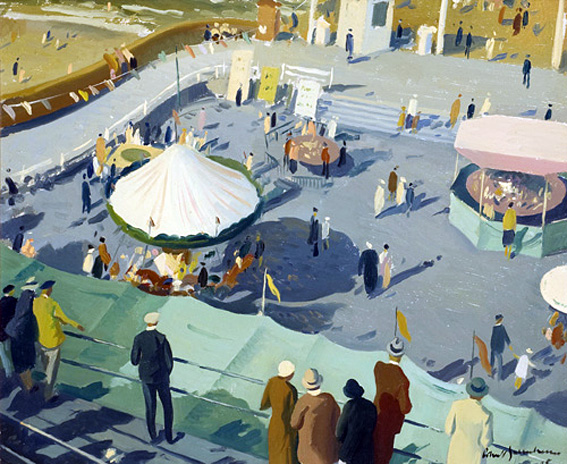
Greenham was a painter and print maker who studied at Byam Shaw School and at the Royal Academy Schools. He was especially fond of painting beach scenes, his slightly stylised draughtmanship and unique palette being instantly recognisable. His brother was the artist Peter Greenham.
Posted in INSPIRATION | Comments Off on FAIR AT CROMER
Entry from 20th August 2007
Postcards by the Flemish Northern Renaissance painter Lucas Van Valckenborch showing ‘Winterlandschaft bei Antwerpen mit schnaeefall’ (1575) and ‘Ansicht von Antwerpen mit zugerfrorener schelde’ (1590).
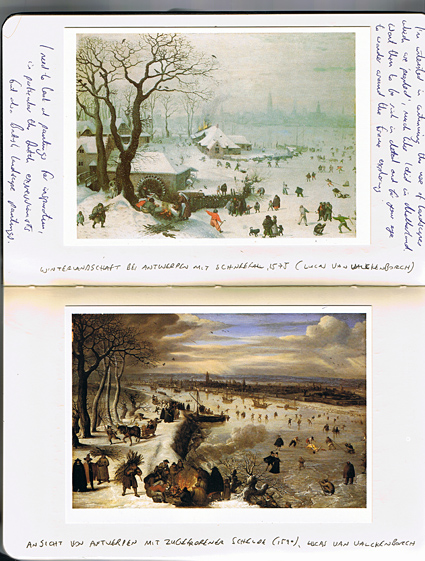
Entry from 2nd November 2007
Postcards showing John Constable’s ‘The White Horse’ (1819) and ‘Salisbury Cathedral from the Bishop’s Garden’ (1826) from the Frick Collection.
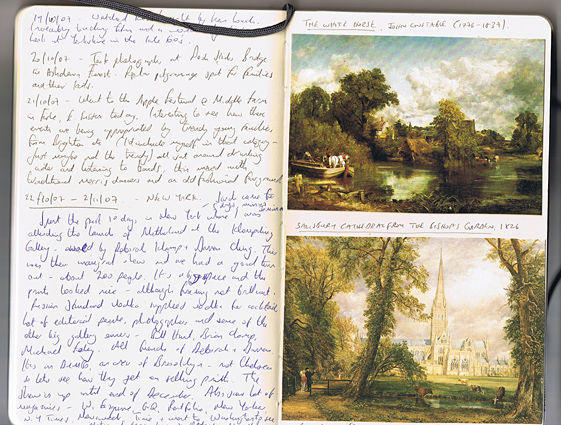
Entry from 25th January
Postcard of ‘The Browne Family’ (c. 1778) by Francis Wheatley from Paul Mellon Collection
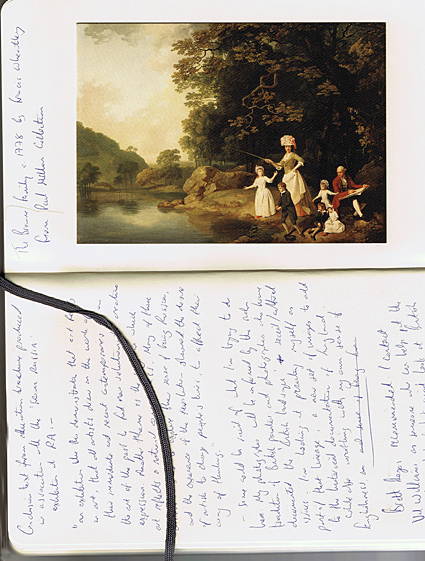
Entry from 6th February 2008
Postcards showing Jeff Wall’s ‘In front of a nightclub’ 2006 from the Museum of Contemporary Art, Chicago and Hendrick Avercamp’s ‘A scene on the ice near a town’ (c.1615) from the National Gallery.
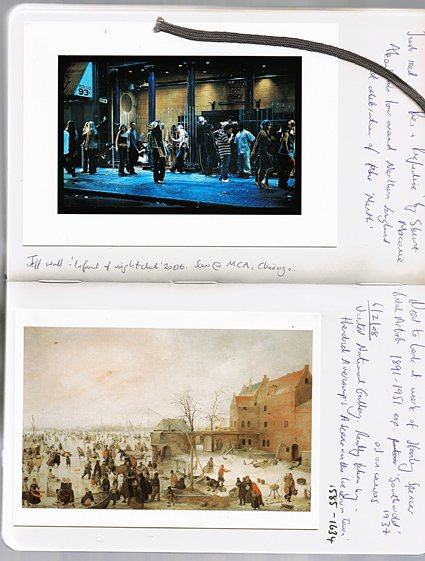
Posted in INSPIRATION | 1 Comment »
On a trip back from Amsterdam recently I came across a newspaper cutting with an article entitled ‘Man goes golfing after jet crash destroys home’ (see cutting in my scrap book below). A story that goes some way to highlight the sometimes bizarre devotion the English have for sporting pastimes. Eddie Harman, 72, was in Spain when he was told that a plane had crashed into his home in Farnborough, killing five people. His wife came home from a separate holiday to cope with the aftermath, however, Mr Harman played a round of golf before returning to England. He is quoted as saying “I think a round of golf helped take my mind off things.”
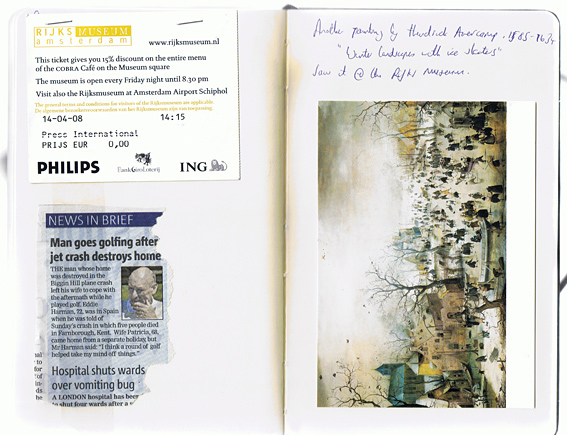
While I was in Amsterdam I visited the Rijks Museum. Although the building is currently undergoing major renovation, there is still an opportunity to see a selection of the museum’s masterpieces. A small but wonderful display of Dutch paintings. Given my current interest in leisure, I was particularly taken by Hendrick Avercamp’s ‘Winter landscape with iceskaters’. Avercamp (1585-1634) was one of the first landscape painters of the 17th-century Dutch school, and the most famous exponent of the winter landscape. He was deaf and dumb and known as de Stomme van Kampen
(the mute of Kampen).
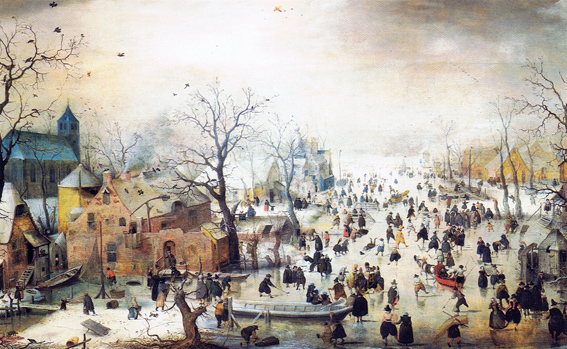
Winter Landscape with Iceskaters, c. 1608
In this painting, one of the earliest large winter landscapes in the Rijksmuseum, crowds of people are depicted on the ice in a scene that stretches far into the distance. There is considerable variety among the figures, both in clothing and in what they are doing. Some of those portrayed are having fun, while others appear to be working. Avercamp has included several daring details, such as the couple making love, the bare buttocks and the man urinating.
Another wonderful example of Avercamp’s winter landscapes is: ‘A winter scene with skaters near a castle’ (1585), reproduced here-
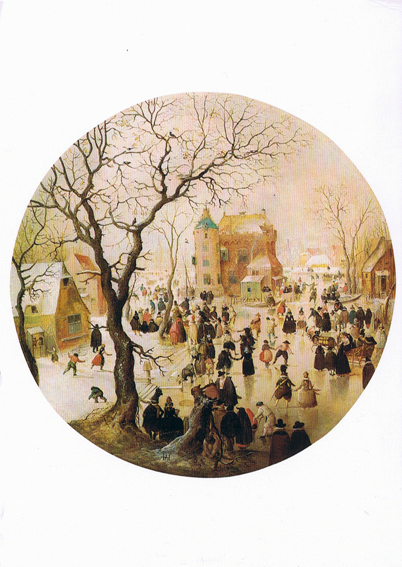
I’m going to look at paintings in more detail in a future post. In the meantime, if you have any suggestions of paintings that depict scenes of leisure and pastimes, particularly in the English landscape, please post them below.
A few for starters –
William Powell Frith ‘Derby Day’ (1856-8)
Philip Wilson Steer ‘A Procession of Yachts’ (1892-3)
James Tissot ‘Holyday’ (c. 1876)
Posted in ART & LEISURE, INSPIRATION, TRIP LOGISTICS | Comments Off on A PAGE FROM MY SCRAP BOOK
“…the surprising thing about Ray-Jones was that he had a different idea of what subject matter was possible for serious photography. It did not have to be heroic or poetic in any overt sense: it could be on the surface as tedious or as bland as our real tedious and bland lives usually are, and the photographs might still be compelling.”Â
John Szarkowski, Director of Museum of Modern Art, New York (1962-1991)
Â
“His work spanned just a decade – he died aged 30 – but with his striking 1960s images of Britons at play, Tony Ray-Jones helped change the face of British photography for ever.”
Â
Liz Jobey, The Guardian, 2004
Â
Books of Tony Ray-Jones’ work-
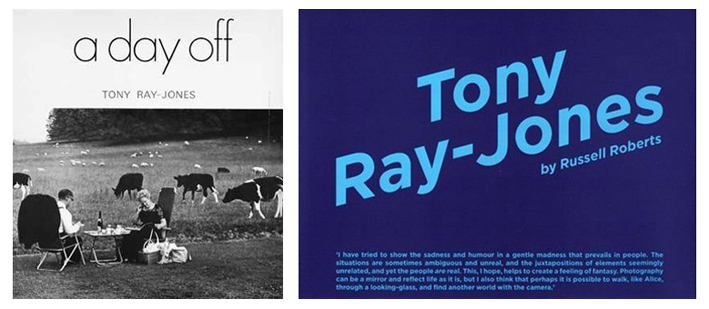
As part of my research for this project, last summer I paid a visit to the National Media Museum Photography Collection in Bradford whose extensive collection encompasses not only that of The Royal Photographic Society Collection, the Kodak Museum and the Daily Herald Archive, but also the Tony Ray-Jones archive. Many of the original photographs from Ray-Jones’ classic book on England ‘A Day Off; an English journal’ (Thames & Hudson) are held in the Collection alongside his diaries and notes from the project.
Given the huge significance of Ray-Jones’ landmark book ‘A Day Off’ (which was published in 1974 after his death) and its legacy as a document about England and Englishness, I was keen to see his original prints and read extracts from his diary in person.  On a personal note, Ray-Jones’ work had also been an important influence in my early development as a photographer and given I’m now about to depart on my own photographic journey around England,  I wanted to explore a bit deeper the work of this visionary artist.
Of his work in England, Ray-Jones wrote in Creative Camera (1968): “My aim is to communicate something of the spirit and the mentality of the English, their habits and their way of life, the ironies that exist in the way they do things, partly through tradition and partly through the nature of their environment…For me there is something very special and rather humorous about the ‘English way of life’ and I wish to record it from my particular point of view before it comes Americanised. We are at an important stage in our history, having in a sense just been reduced to an island or defrocked and, as De Gaulle remarked, left naked.â€
In the introduction to his book ‘Tony Ray-Jones’ (Chris Boot Ltd, 2004) Russell Roberts writes “A Day Off…..contrasted the veneer of modern leisure with a perception of the deeper significance of tradition and custom. It is an image of England from the perspective of both insider and outsider, employing a mix of empathy and ironic detachment, and laced with sardonic wit and pathos.â€
and
“Looking at A Day Off we do not see a stoic, entrenched nationalism in the face of imported values, but an account of Englishness that constitutes a more playful commentary about identity. His point about an England becoming increasingly Americanised invites us to find in these photographs traces of US influence and possible sites of English resistance. The celebration of ‘local culture’ heightens the differences in Englishness, and he presents a range of images that both reflect and undermine stereotypes.â€
It was fascinating (and humbling) to read Ray-Jones’ notebooks, which were full of lists, plans and ideas for possible pictures for his England work and revealed an extremely methodical approach to his organizing of the project. As seen here where he outlines possible ideas by location and places alphabetically –
Â
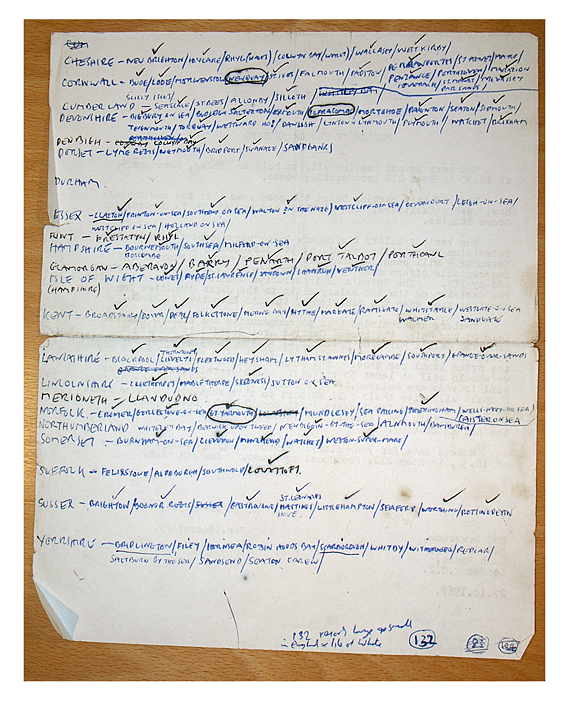
© Tony Ray-Jones/National Media Museum
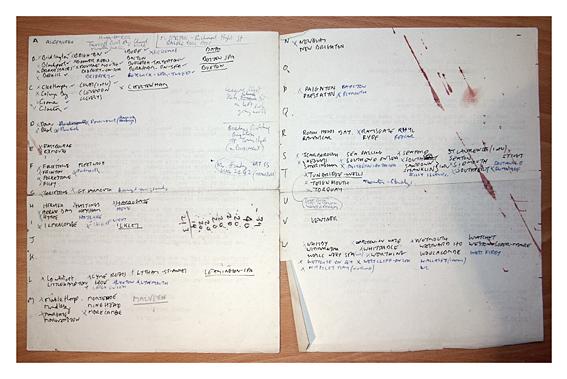
© Tony Ray-Jones/National Media Museum
Â
Extracts from his diaries highlight some of the struggles he encountered balancing editorial assignments and producing his own work, as well as funding the project. There was also a fascinating list, headed ‘APPROACH’:
Â

© Tony Ray-Jones/National Media Museum
Â
which I’ve reproduced here-
·      BE MORE AGGRESSIVE
·      GET MORE INVOLVED (TALK TO PEOPLE)
·      STAY WITH THE SUBJECT MATTER (BE PATIENT)
·      TAKE SIMPLER PICTURES
·      SEE IF EVERYTHING IN BACKGROUND RELATES TO SUBJECT MATTER
·      VARY COMPOSITIONS AND ANGLES MORE
·      BE MORE AWARE OF COMPOSITION
·      DON’T TAKE BORING PICTURES
·      GET IN CLOSER (USE 50mm LESS)
·      WATCH CAMERA SHAKE (shoot 250sec or above)
·      DON’T SHOOT TOO MUCH
·      NOT ALL AT EYE LEVEL
·      NO MIDDLE DISTANCE
Â
Finally, a letter on headed note paper dated May 25 1965, highlight Ray-Jones’ social concerns as a visual artist –
Â

© Tony Ray-Jones/National Media Museum
Â
Posted in INSPIRATION | 9 Comments »

















